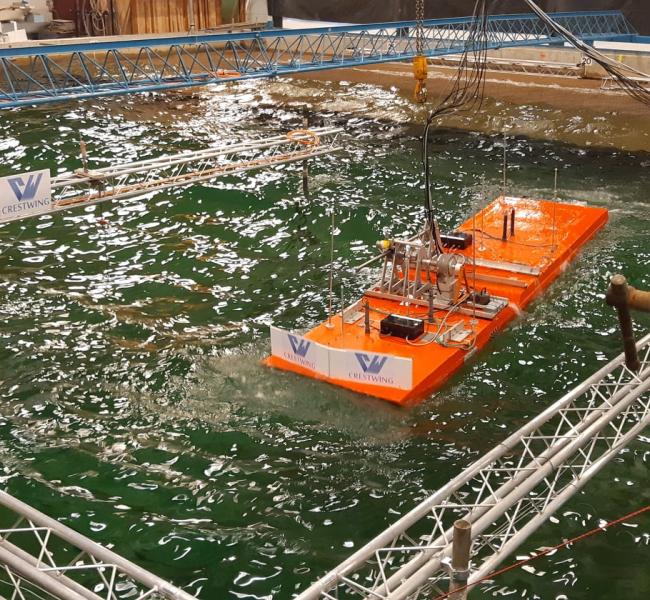Introduction
Marine energy technologies are deployed in harsh yet sensitive environments that present challenges for all forms, including wave, tidal, river, thermal, and salinity. After designing and building a new marine energy converter the question becomes, “What is the best way to test it for energy production?” Developers and funding groups want to know how well a device performs when making decisions for future development. Robust testing is needed at all technology readiness levels (TRLs), from concept to product, and at all scales, from watts to megawatts to reduce technical, environmental, and fiscal risk while optimizing performance and acceptance. This page provides links to testing standards, testing facilities, discussion of different scales and types of testing, and measurement standards. Lessons learned by other developers are included as well.
The scope of the concept 'testing' is large and this page will continue to expand with input from experts in the field.

Crestwing testing their wave attenuator design in a wave tank.
Testing Facilities
The TEAMER Facility Networks are representative of the top tier of marine energy testing and expertise facilities in the United States. All facilities listed on the TEAMER facility pages have been approved by the TEAMER Technical Board and are able to provide testing or expertise to TEAMER applicants. Please visit their website for more information.
Open Water Test Sites
The Test Sites section of the PRIMRE Projects Database defines test sites as open-water locations where device prototypes can be tested in real conditions. Since permitting marine energy for tests in open water can be a lengthy process, test sites have been created around the world to enable fast-tracked testing of device prototypes. These test sites often have research support staff, servicing infrastructure, detailed resource assessments, cable connections, and existing blanket environmental permits to support the tests.
National Marine Energy Centers
National Marine Renewable Energy Centers (NMECs) are institutions that support research, development, testing, and commercialization of marine energy technologies. The Department of Energy's Energy Efficiency and Renewable Energy agency manages NMECs and offers grants to higher education institutions to establish new centers and use existing ones. As of 2025, there are four NMECs:
The Center is a collaboration of the University of New Hampshire, Stony Brook University, Lehigh University and the Coastal Studies Institute. It works to advance marine energy technologies and the Blue Economy, including aquaculture.
This Center was funded by WPTO from 2009 to 2019. Research continues as a self-funded collaboration of the Hawaii Natural Energy Institute (HNEI) at the University of Hawaii and the U.S. Navy Wave Energy Test Site (WETS).
Located at Florida Atlantic University, SNMREC’s emphasis is on resources available to the Southeastern U.S., like ocean currents and offshore thermal resources (OTEC). Focus areas include education and outreach; tech development; resource characterization; environmental assessment; technology testing, and the regulatory framework.
PMEC is a consortium of the University of Washington, Oregon State University and University of Alaska Fairbanks which works closely with technology developers, National Labs, community stakeholders and regulators.
Marine Energy Testing
This section provides a detailed overview of the rationale for a robust technology testing program, defines how to plan a test, describes the components of a test plan, and provides detailed descriptions and links to guidance documents for the various types of tests performed in component, laboratory and field testing programs.




Data Acquisition




Data Processing



TEAMER
The Testing Expertise and Access for Marine Energy Research (TEAMER) program aims to accelerate the viability of marine renewables by providing access to the United States’ best facilities and expertise in order to solve challenges, build knowledge, foster innovation, and drive commercialization.
Testing and Measurement Standards
The establishment of international standards assist in mitigating the technical and financial risks associated with the diverse range of technology concepts that currently exist in the marine energy industry, enabling a quicker uptake of commercial systems. The International Electrotechnical Commission (IEC) works to promote world-wide cooperation on equipment design and operation in the field of marine energy, as well as many others. To this end the IEC publishz international standards, technical specifications, guides, and other reports to further knowledge. Standards are produced with the consensus of national committees, international, governmental, and non-governmental organizations. These standards represent an international consensus of opinion on their subject matter, in this case wave, tidal, and river resource assessments.
Links below provide an abstract for the standards and a link for purchase from the IEC. A full list of standards of interest to marine energy projects can be found at PRIMRE’s Standards page
IEC Standards
- Assessment of Mooring Systems IEC TS 62600-10
- Power Performance Assessment (Wave) IEC TS 62600-100
- Power Performance Assessment (Tidal) IEC TS 62600-200
- Testing Pre-Prototype Devices IEC TS 62600-103
- Testing Pre-Prototype Scale Devices IEC TS 62600-202
- Power Performance Assessment (River) IEC TS 62600-300
- Measurement of Mechanical Loads IEC TS 62600-3
- Acoustic Characterization of Mare Energy Convertors IEC TS 62600-40
Lessons Learned
The PRIMRE team has conducted semi-structured interviews with marine energy subject matter experts to collect lessons learned from past and present marine energy research, testing, and deployment projects. The summary of this information aims to ensure that knowledge is not lost, past mistakes are avoided, and hard-won successes are capitalized on. Lessons learned from projects in the testing and measurement phase include:








